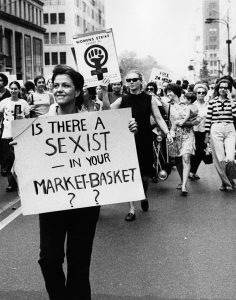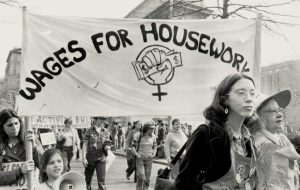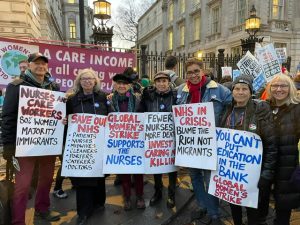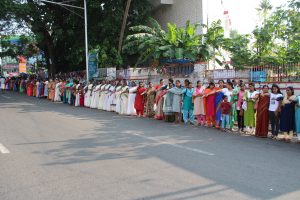2 Empowering Women and Economies: An Intersectional Analysis of the Global Women’s Strike Movement
Introduction:
While the specific name “Global Women’s Strike Movement” may have gained increased visibility in recent years, the struggle for fair compensation and recognition of care work has been an ongoing battle. The Global Women’s Strike Movement is part of a larger global feminist movement that has seen women mobilizing and organizing protests and events worldwide to advocate for gender equality, reproductive rights, and economic justice. Examples from different countries, such as India, Iceland, Argentina, and Spain, demonstrate the power of collective action and the disruption of societal norms. The movement seeks to call attention to the unpaid care work that women perform globally and advocates for recognizing this work as valid and necessary in the labor force. What distinguishes the GWSM is its contemporary resurgence and global reach, encompassing diverse feminist groups and organizations by amplifying women’s voices and advocating for systemic changes; the GWSM challenges the prevailing societal norms that perpetuate gender inequalities and marginalize care work.
The GWSM emerged in the context of the increasing neo-liberalization of economies worldwide, which led to the dismantling of social welfare programs and the privatization of public services. These processes negatively impacted women, who are disproportionately responsible for caregiving and often rely heavily on social services like healthcare, childcare, and education. According to a report by the United Nations, women worldwide perform approximately three times the amount of unpaid care work compared to men. By emphasizing the need for a thorough intersectional analysis, this paper explores the Global Women’s Strike Movement’s potential to empower both women and economies simultaneously.

To further illustrate the impact of the Global Women’s Strike Movement, it is necessary and crucial to consider the coalition’s historical roots. The GWSM can be traced back to the 1970 Women’s Strike for Equality, a nationwide strike within the U.S. The walkout was organized by the National Organization for Women and was attended by thousands of women. The Women’s Strike for Equality was a turning point in the Women’s Rights Movement, as it brought attention to the issues of gender inequality and discrimination issues that discourage change-driven legislation. The strike was focused on promoting progress and advancement and helped push for the passage of Title IX and the Equal Credit Opportunity Act. This precedent is evident in Mohanty’s claim that the U.S. movement used to be more radical in the 1970s and 1980s. Several economic transformations have already occurred, including policies such as paid parental leave, flexible work arrangements, and minimum wage increases. There has also been increased attention to the need for affordable and accessible childcare, healthcare, and education, as well as the importance of addressing the gender pay gap and ensuring that women have equal access to opportunities.
Italian feminists in the 1970s advocated for wages for housework, emphasizing women’s labor and economic contribution in the domestic sphere. The GWSM, emerging in the 1990s, builds upon these earlier efforts by adopting a transnational approach that connects women’s struggles across borders and addresses the global economic policies perpetuating gender inequality and poverty. It draws inspiration from various feminist movements and organizations worldwide, such as the International Wages for Housework Campaign and the Global Women’s Strike, which have long fought for the recognition and redistribution of unpaid care work.

The Global Women’s Strike Movement must incorporate an intersectional approach to impact and fight for all women. This holistic perspective recognizes that gender often combines with other social identities, such as race, class, and sexuality, to shape experiences of inequality and discrimination. A convergent analysis confronts how power is unevenly dispersed between women themselves and how those with privilege must provide a platform for those facing deep-rooted oppression. By identifying and praising women’s mass exertion of effort, the GWSM seeks to accredit them transnationally by providing women with a platform to contribute to the growing sense of agency to legitimize the women’s care industry.
Several countries and regions have garnered increased attention towards addressing the necessity for affordable and accessible childcare, healthcare, education, and gender pay equity. Notable examples include the Canada Child Benefit and investments in early learning and childcare programs to alleviate financial burdens on families and promote women’s economic empowerment. New Zealand’s Well-being Budget of 2018 allocated substantial investments towards mental health services, education, and poverty reduction, specifically on closing gender gaps and reducing inequalities. Additionally, the European Union has pursued gender equality through initiatives like the European Institute for Gender Equality (EIGE), which advocates for gender mainstreaming in policies and offers resources and tools to address gender imbalances in employment, education, and healthcare. These examples exemplify ongoing endeavors to tackle the imperative of affordable and accessible services, diminish gender disparities in pay and opportunities, and cultivate an environment encouraging women’s active participation in the workforce.
Structural gender inequalities can limit the talent available to businesses, resulting in lower productivity and competitiveness. By organizing strikes and protests, the movement is questioning the traditional roles that women are expected to embody in society, like submissiveness. The GWSM interrogates normalized enforcement of gender stereotypes and the concept that women are responsible for all the care work in the family, while men are the primary breadwinners. While in fact, this is how society and institutions have mandated the household to operate because men earn a higher wage than women and sexual dimorphism is constantly used to justify men’s more noticeable presence in the workforce. For instance, the slogan “Wages for Housework” has been a prominent rallying cry within the GWSM since its beginning.
According to A McKinsey Global Institute, closing the gender pay gap and achieving gender equality in the workforce could add $12 trillion to global GDP by 2025. This statistic highlights the significant economic potential that lies in promoting gender equality. The World Bank has also published studies proving that reducing gender-based discrimination and increasing women’s access to education and employment opportunities can lead to higher productivity, increased innovation, and enhanced economic stability.
Concrete evidence of the GWSM’s efforts can be found in the numerous campaigns and initiatives aimed at challenging gender norms and advocating for policies that support women’s economic empowerment. For example, the Care Income Now! campaign, supported by the GWSM, advocates for a universal basic income for caregivers to recognize and value their essential work.


Theoretical Frameworks:
The Global Women’s Strike Movement demonstrates its commitment to intersectionality by engaging in collaborative efforts with organizations that specifically address the challenges faced by women of color, immigrant women, disabled women, and LGBTQ+ women. Through alliances with immigrant rights organizations like the National Domestic Workers Alliance and United We Dream, the GWSM addresses immigrant women’s unique concerns, such as advocating for comprehensive immigration reform, protecting them against exploitation, and ensuring access to vital social services. Moreover, by collaborating with disability rights organizations such as the Disability Rights Education & Defense Fund and the National Council on Independent Living, the GWSM actively champions the rights of disabled women, emphasizing the need for accessible healthcare, inclusive employment practices, and policies that uphold their dignity and promote inclusivity in all spheres of life. Through these collaborative initiatives, the GWSM recognizes and addresses the challenges women face at the intersections of various social identities, contributing to a more inclusive and equitable feminist movement.
The paper “Gender and Globalization: A Macroeconomic Perspective” authored by Nilüfer Çağatay and Korkuk Ertürk explores the relationship between gender and economic globalization, calling attention to how gender inequalities are produced, reproduced, and intensified through global economic processes. Çağatay and Ertürk’s study on gender and globalization stresses how globalization has increased gender inequality, particularly for women in developing countries. Women in these countries are often employed in low-wage, insecure jobs in the informal sector and perform significant additional unpaid care work. The authors argue that mainstream macroeconomic models have failed to capture the gender dimensions of economic globalization and that there is a need to incorporate a feminist perspective to develop more comprehensive and accurate economic models. They propose an alternative macroeconomic framework that considers the gendered nature of labor markets, trade patterns, and financial flows, accentuating the importance of redistributive policies to address gender inequalities in the global economy. The framework provides a revised theoretical structure for understanding the global economic forces that shape women’s lives while fortifying the need to address these issues through policy and advocacy efforts. While acknowledging that mainstream macroeconomic models have neglected the gender dimensions of globalization, the authors argue for integrating a feminist perspective in economic frameworks.
In this regard, the work of feminist economists like Lourdes Benería, as exemplified in her book “Gender, Development, and Globalization: Economics as if People Mattered,” has been instrumental in highlighting the significance of paid and unpaid labor and their intersectional implications within the context of globalization. By emphasizing the importance of valuing and recognizing various forms of labor, Benería, and other feminist economists have played a crucial role in shaping policy discourse and advocating for more equitable and inclusive economic systems. Their contributions have informed the International Association for Feminist Economics and broader academic discussions, promoting a comprehensive understanding of the interconnections between gender, development, and globalization.
Specifically, Sundari Anitha, Ruth Pearson, and Linda McDowell’s study of South Asian women’s employment, identity, and protest in the U.K. highlights how race, gender, and class connect and shape women’s experiences in the workforce. Their article “Striking Lives” explores the experiences of South Asian women in the U.K. labor market and their participation in protests, especially the Global Women’s Strike movement. The authors conducted and analyzed interviews with 150 women to present a range of narratives and experiences of South Asian women in the U.K., highlighting the diversity of their experiences and the complex ways they negotiate their employment and identity.
Many women took up two or more jobs to balance their productive and reproductive roles. These women also perform significant unpaid care work, limiting their time, opportunities, and choices. The authors conclude that paid employment can provide South Asian women with independence, agency, and freedom through a universal, traditional payment. However, these roles are also a source of conflict and tension, particularly when they conflict with traditional gender roles and familial expectations. The writers reveal the part trade unions and community groups play in supporting and empowering South Asian women to challenge discrimination and inequality in the workplace and broader society. “Unionization, collective action, and community-based organizations… [enable women] to articulate their demands and gain access to employment rights and benefits.” While the article does not propose specific solutions, it cements that there is a need for policymakers, employers, and trade unions to admit the existence of the specific obstacles faced by South Asian women workers, such as language barriers, discrimination, and cultural expectations.
The Global Women’s Strike movement sought to challenge the current, dominant economic model by calling for the redistribution of wealth and resources to ensure that women, similar to the standards Çağatay and Ertürk wrote about, are not left behind in the global economy. One of the critical demands of the GWSM was the introduction of a Universal Basic Income (UBI), which would provide a minimum level of financial support to all individuals regardless of their employment status. Many leaders in the GWSM believe UBI would recognize the value of unpaid care work and provide women with the economic security they need. UBI could provide a safety net for women who face barriers to participation in the formal economy, such as caregiving responsibilities, discrimination, and lack of access to education and training. UBI would provide a guaranteed income for all individuals regardless of their employment status, which helps alleviate poverty and provide greater financial stability for women who may not have access to traditional forms of employment. Additionally, UBI could help reduce gender-based inequality in the workforce, providing an equal starting point for all individuals, regardless of gender. With a guaranteed income, women may negotiate for better working conditions, take on entrepreneurial ventures, or pursue education and training opportunities without fear of financial insecurity.
The Case:
The New York Times article by Sascha Cohen titled “Women’s Equality Day” overviews International Women’s Day in 2017, articulating the various calls to action, protests, and events worldwide and demonstrating the diverse ways women are mobilizing and organizing these issues locally and globally. The article notes that International Women’s Day has historically been a day of activism and protest. Globally, not so much in the U.S., which is a recent phenomenon even though part of the day’s history occurred in the U.S. In India, International Women’s Day is celebrated and recognized as a public holiday in certain states.
In Kerala, International Women’s Day is celebrated as “Vanitha Mathil” or “Women’s Wall.” In this initiative, women unite to form a human chain that stretches over 380 miles to raise awareness about gender equality and women’s rights. Beginning in 2018, one such trigger was the widespread protests and discussions that followed the Supreme Court’s ruling in September 2018 allowing women of all ages to enter the Sabarimala temple, previously barred to women of menstruating age. The Supreme Court’s decision led to protests, with conservative groups and individuals opposing the ruling and organizing demonstrations against women entering the temple. In response to these events, women’s organizations and activists in Kerala recognized the importance of raising awareness and mobilizing support for women’s rights. The Women’s Wall emerged as a powerful means to symbolize unity, resilience, and the collective strength of women in the face of gender-based discrimination. The Women’s Wall was conceived as a direct response to the resistance against women’s entry into the Sabarimala temple to challenge patriarchal norms and advocate for gender equality in broader societal spheres. The Women’s Wall event has since evolved into an annual occurrence.

Yet, in recent years, it has taken on added significance in response to the rise of populist and nationalist movements around the globe. Cohen emphasizes how women have been at the forefront of many of these movements, both as organizers and participants, and the continued need for action and advocacy around issues such as gender equality, reproductive rights, and economic justice. In India, women organized protests against sexual harassment and violence, calling for stronger laws and better enforcement to protect women’s safety. In Afghanistan, women’s coalitions are working to promote education and economic empowerment, despite ongoing violence and discrimination against women in many parts of the country and the Taliban. In Brazil, women are fighting structural gendered violence against women, particularly in rural areas where women are often isolated and vulnerable.
The Icelandic Women’s Strike, where women congregated in Reykjavik, the capital city of Iceland, to actively engage in constructive dialogues about women’s rights and the pursuit of gender equality, is a powerful example of collective action aimed at disrupting the societal norms that undervalued women’s work. An estimated 90% of Icelandic women participated in the strike on October 24, 1975. Afterward, the 1976 Gender Equality Act was passed, which prohibited gender-based discrimination in employment and education and aimed to promote equal opportunities for women in various domains.

In 2018, Chile witnessed a series of feminist strikes known as “La Huelga Feminista” or the Feminist Strike. Women’s rights groups and activists organized these strikes to raise awareness about gender inequality, violence against women, and discrimination.
The feminist strikes in Chile were part of a larger international movement that gained momentum under the slogan “Ni Una Menos” (“Not One Less”), which emerged in Argentina in response to femicides (gender-based killings of women) and other forms of violence against women. The movement spread across Latin America and other parts of the world, inspiring women to take collective action and demand change. A distinctive feature of these strikes was the symbolic form of protest known as “cacerolazo,” where women boldly banged pots and pans to amplify their voices and demand change. By repurposing everyday objects associated with domesticity into tools of activism, women challenged traditional gender roles, magnified their demands, and asserted their agency. This performative act blurred the boundaries between the private and public spheres, effectively reclaiming public spaces for women’s voices. The cacophony created by the protest served as a powerful metaphor for the disruptive force and attention women demanded. The protest cut through complacency, drawing society’s attention to the urgent need for gender equality and social justice.

The women’s strike in Spain in 2018 epitomized a transnational feminist movement that aimed to confront gender-based violence, unequal pay, and various forms of discrimination. Notably, the strike embraced a unique and creative method of protest: dance. The act of collective dancing became an embodiment of solidarity and a rejection of the isolation that patriarchy perpetuates. Through synchronized movements and choreographed routines, women showcased their unity, disrupting the notion that their struggles were individualized. Moreover, the feminist flashmob demonstrated a reclamation of the female body and its expression. Through dance, women asserted their autonomy and challenged the objectification and control historically imposed on their bodies. The choreography and movements performed by the participants embodied a celebration of femininity, strength, and resilience. By reclaiming their bodies in public spaces, women challenged patriarchal constructs that dictate how they should present themselves and undermined traditional gender roles that seek to confine and silence them.

In the article “Care? A Word under Political Dispute,” authored by Danica, the complex nature of the term “care” within political discourse is examined. Danica delves into the intricate dimensions of care. She highlights how care has been utilized by different political actors and interest groups, resulting in divergent interpretations and contested meanings attributed to this concept.
Acknowledging the historical association of care with women’s unpaid labor, the article recognizes how care has long been marginalized as a personal responsibility, perpetuating gender inequalities. In this context, the article sheds light on how care work has become a central focus of the GWSM, which seeks to challenge and transform the undervaluation and exploitation of care labor. “Care, once confined to the private domain, has become a rallying cry in the public sphere, challenging the status quo and demanding recognition of its transformative potential.” This quote from Danica captures the shifting dynamics surrounding care and the transformation of care from a traditionally marginalized and invisible sphere to a focal point of political mobilization. By asserting its presence in the public sphere, care disrupts established power structures and calls for reevaluating its transformative capacity.
Analysis: Domestic Work Via the Integration of Social & Labor Movement Frameworks
Despite many successes, there are challenges to the Global Women’s Strike Movement. One is the resistance to recognizing unpaid care labor as valid work, qualified for compensation, and the belief that it is a woman’s natural role to perform these daily tasks. Stereotypes like these can be challenging to overcome, as they are deeply ingrained in cultural and social norms. To overcome them, the GWSM needs to continue to raise awareness about the importance of unpaid care work and to advocate for policies and programs that support women. The movement also needs to continue to expand its focus to include issues of race, class, and sexuality and to recognize how gender intersects with other social identities to shape experiences of inequality and discrimination. By doing so, the movement can continue to empower women and economies and transform how we think about and value women’s work and contributions to society.
Another critical challenge to the GWSM is the hegemonic narratives that reinforce traditional gender roles and devalue unpaid care work. These narratives are perpetuated by dominant cultural and economic systems prioritizing profit over people and reinforcing the gendered division of labor. Manuel Castells’ work on the network society emphasizes the influence of these systems on shaping identity and meaning, elucidating how unpaid care work becomes marginalized within such contexts. In his work, Castells highlights the pervasive influence of dominant cultural and economic systems in shaping individual and collective identities and the associated meanings attached to different forms of labor. Within these systems, unpaid care work often becomes marginalized and devalued, as it does not align with the profit-driven objectives these systems prioritize. The emphasis on productivity and economic output tends to overshadow the essential role of care work, relegating it to the periphery of societal recognition and reward. By exploring the intricate connections between the network society and the devaluation of care work, Castells provides valuable insights into the underlying mechanisms that perpetuate traditional gender roles and contribute to the marginalization of care within contemporary social and economic contexts. The analysis underscores the Global Women’s Strike Movement’s need to challenge and transform these systemic dynamics, advocating for the recognition, valuation, and redistribution of care work within a more equitable framework.
In order to challenge and transform hegemonic narratives, the Global Women’s Strike Movement must engage in counter-hegemonic practices that disrupt and challenge dominant discourses and promote alternative ways of thinking about work, care, and gender roles. Counter-hegemonic practices can take many forms, including grassroots organizing, media activism, and cultural interventions. The GWSM has continually pursued counter-hegemonic tactics, used social media to amplify the voices and experiences of women who perform unpaid care work, and challenged the idea that this work is a natural and innate aspect of femininity. The movement has organized rallies, protests, and strikes that disrupt business as usual, drawing attention to how unpaid care work is trivialized and unrecognized.
The Global Women’s Strike Movement is both an enabler and a catalyst for women to assume leadership positions and drive transformative change. However, it is essential to acknowledge that women’s participation in leadership roles within the movement is not solely a matter of choice but often a consequence of their heightened vulnerability and the urgent need for their voices to be heard. Women’s disproportionate risk and direct experience of oppression and marginalization often thrust them into leadership positions within the GWSM.
Ultimately, the Global Women’s Strike Movement can transform how people think about and classify unpaid care work. The movement recognizes that addressing the specific challenges women face is crucial for achieving meaningful and inclusive change. By incorporating an intersectional analysis, the GWSM goes beyond a one-size-fits-all approach and recognizes gender-based oppression’s complex and interconnected nature.
Conclusion:
In conclusion, the Global Women’s Solidarity Movement has emerged as a formidable force in challenging gender-based divisions and reshaping societal norms on a global scale. The movement’s endeavors have yielded profound impacts, particularly in relation to the recognition and valuation of women’s care work, which in turn has significant implications for the transnational economy.
The GWSM’s concerted efforts have effectively disrupted prevailing notions that marginalized care work is a private, unpaid responsibility primarily assigned to women. By foregrounding the pivotal role of care work in driving economic development, the movement has propelled a fundamental reevaluation of its intrinsic worth and societal contributions. Through strategic advocacy, awareness campaigns, and policy interventions, the GWSM has successfully shed light on the labor-intensive nature of care work and its indispensable role in sustaining and reproducing the workforce.
Central to the movement’s impact is the repositioning of care work as an essential component of economic systems, challenging traditional understandings of labor and productivity. By emphasizing the interconnectedness between care work and broader economic processes, the GWSM has engendered a paradigm shift, necessitating the integration of care into economic policy frameworks and the acknowledgment of its transnational significance. Consequently, policymakers and stakeholders have been compelled to grapple with the implications of care work on macroeconomic indicators, including employment, productivity, and social welfare.
Moreover, the GWSM’s emphasis on the gendered nature of care work has unveiled the structural inequalities embedded within economies. By highlighting the disproportionate burden borne by women in performing care tasks, often at the expense of their own professional aspirations and economic opportunities, the movement has underscored the urgent need for gender-responsive policies and redistributive measures. This awareness has catalyzed policy discussions surrounding equitable access to affordable and quality care services, as well as the recognition of care work as valuable economic activity deserving of fair remuneration and social protection.
Bibliography
Agency, Canada Revenue. “Government of Canada.” (CCB) – Canada.ca. / Gouvernement du Canada, April 6, 2023. https://www.canada.ca/en/revenue-agency/services/child-family-benefits/canada-child-benefit-overview.html.
Anitha, Sundari, Ruth Pearson, and Linda McDowell. “Striking Lives: Multiple Narratives of South Asian Women’s Employment, Identity and Protest in the UK.” Ethnicities 12, no. 6 (2012): 754–75. http://www.jstor.org/stable/43573268.
Anitha, Sundari, and Ruth Pearson. “Striking Women—Striking Out.” Feminist Review, no. 108 (2014): 61–70. http://www.jstor.org/stable/24571920.
Beneria, Lourdes, et al. Gender, Development and Globalization: Economics As If All People Mattered, pages 179-226, Taylor & Francis Group, 2015. ProQuest Ebook Central, http://ebookcentral.proquest.com/lib/claremont/detail.action?docID=3570072.
Bracke, Maud Anne. “Between the Transnational and the Local: Mapping the Trajectories and Contexts of the Wages for Housework Campaign in 1970s Italian Feminism.” Taylor & Francis, April 15, 2013. https://www.tandfonline.com/doi/full/10.1080/09612025.2012.751771?scroll=top&needAccess=true&role=tab&aria-labelledby=full-article, 625-642.
Brewer, Kirstie. “The Day Iceland’s Women Went on Strike.” BBC News. BBC, October 23, 2015. https://www.bbc.com/news/magazine-34602822.
Çağatay, Nilüfer, and Korkuk Ertürk. “Gender and Globalization: A Macroeconomic Perspective.” Accessed February 24, 2023. https://www.ilo.org/legacy/english/integration/download/publicat/4_3_204_wcsdg-wp-19.pdf.
Castells, Manuel. 2010 [1997]. Selection from Chapter 1: “Communal Heavens: Identity and Meaning in the Network Society,” pp. 5-10 in The Information Age. Economy, Society, and Culture.
Cohen, Sascha. “Women’s Equality Day: The History of When Women Went on Strike.” Time. Time, August 26, 2015. https://time.com/4008060/women-strike-equality-1970/.
Danica. “Care? A Word under Political Dispute.” Capire, April 13, 2022. https://capiremov.org/en/analysis/care-a-word-under-political-dispute/.
Federici, Silvia & Ebooks Corporation (2012). Revolution at point zero : housework, reproduction, and feminist struggle. PM Press ; Brooklyn, NY : Common Notions : Autonomedia, Oakland, CA.
Frayer, Lauren, and Sushmita Pathak. “India’s Supreme Court Orders Hindu Temple to Open Doors to Women, but Devotees Object.” NPR. NPR, December 22, 2018. https://www.npr.org/2018/12/22/675548304/indias-supreme-court-orders-hindu-temple-to-open-doors-to-women-but-devotees-obj.
Gaete, Natalia Ojeda. “Las Cacerolas Que Cambiaron El Ritmo Del Gobierno.” CULTURA 21, October 30, 2019. https://www.cultura21.cl/las-cacerolas-que-cambiaron-el-ritmo-del-gobierno/.
Gordon, Eugene. Women’s Strike For Equality (‘Is There A Sexist-In Your Market-Basket?). August 26, 1970. Photograph. The New York Historical Society.
Lane, Bettye. A Wages for Housework March. 1977. Photograph. Schlesinger Library, Radcliffe Institute.
“New Zealand’s Wellbeing Budget: A Good PR Story or a Contributor to Improved Wellbeing?” LGiU. https://lgiu.org/publication/new-zealands-wellbeing-budget-a-good-pr-story-or-a-contributor-to-improved-wellbeing/.
Nugent, Ciara. “Could Amsterdam’s New Economic Theory Replace Capitalism?” Time. Time, January 22, 2021. https://time.com/5930093/amsterdam-doughnut-economics/.
“Our Story.” United We Dream, February 18, 2022. https://unitedwedream.org/who-we-are/our-story/.
“Overview.” World Bank. https://www.worldbank.org/en/topic/gender/overview.
Pérez Orozco, Amaia. (2009). “Global perspectives on the social organization of care in times of crisis: Assessing the situation.
Photograph. n.d.
Photograph. n.d.
Photograph. October 24, 1975. Women’s History Archives.
“Real Justice Is Healing: National Black Women’s Justice Institute.” NBWJI.org. https://www.nbwji.org/.
Salazar, Guille. A La Escucha Del Rumor Social. December 17, 2017. Photograph.
Shanmugam, Sai K. മലയാളം: വനിതാ മതില് – കൊല്ലം. Photograph. Kollam, January 27, 2018. Shanmugam Studio.
Strike, Global Women’s. “Wages for Housework.” Global Women’s Strike/ Wages for Housework/ Selma James, April 26, 2023. https://globalwomenstrike.net/.
Tankersley, Jim. “To Tap Federal Funds, Chip Makers Need to Provide Child Care.” The New York Times. The New York Times, February 27, 2023. https://www.nytimes.com/2023/02/27/us/politics/child-care-chip-makers-biden.html.
The New York Times. “International Women’s Day: Calls to Action, Protests and Words of Praise.” The New York Times. The New York Times, March 8, 2017. https://www.nytimes.com/2017/03/08/world/international-womens-day.html.
Vera, Susana. Women Dance during a Protest as Part of a Nationwide Feminist Strike on International Women’s Day. Photograph. Madrid, Spain, March 8, 2018.
Woetzel, Jonathan, Anu Madgavkar, Kweilin Ellingrud, Eric Labaye, Sandrine Devillard, Eric Kutcher, James Manyika, Richard Dobbs, and Mekala Krishnan. “How Advancing Women’s Equality Can Add $12 Trillion to Global Growth.” McKinsey & Company. McKinsey & Company, September 1, 2015. https://www.mckinsey.com/featured-insights/employment-and-growth/how-advancing-womens-equality-can-add-12-trillion-to-global-growth.
